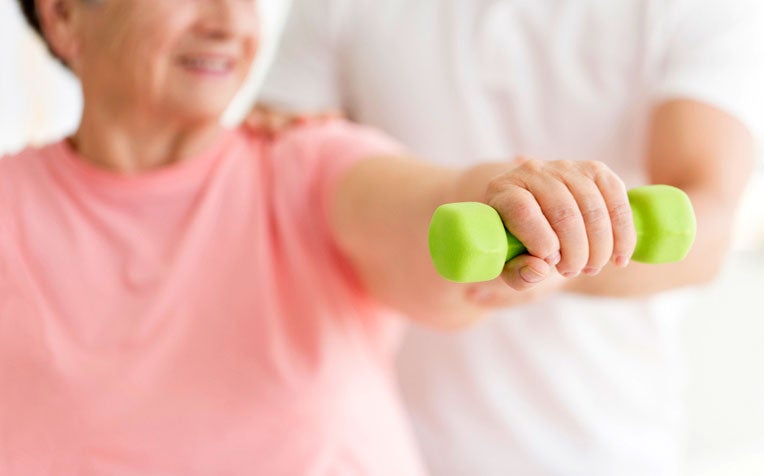
Exercise is an important part of treatment for those who have Parkinson's disease.
Parkinson's disease has no known cause, and it doesn’t have a cure. Its symptoms, the most common of which is tremoring or shaking of the hands, worsen markedly as the disease progresses. And in its later stages, Parkinson’s disease patients with joint and flexibility problems will have difficulty carrying out everyday activities without help.
How exercise benefits those with Parkinson's disease
While medication can help control the symptoms, exercise plays a crucial role in improving flexibility, balance and strength. Patients who exercise feel better physically and mentally, and their quality of life improves.
“We encourage patients to exercise and undergo physiotherapy at the early stage of the disease. While exercise won’t reverse the disease, it will help patients have a better sense of control of their body,” said Dr Lim Ee Wei, Consultant from the Department of Neurology (SGH Campus) at National Neuroscience Institute (NNI), a member of the SingHealth group.
Exercise slows the progression of the disease, according to growing evidence from overseas studies.
The symptoms also appear to develop more slowly in people who were active before diagnosis of the disease, said Dr Dawn Tan, Senior Principal Physiotherapist, Singapore General Hospital (SGH). “Patients who led a sedentary lifestyle tended to succumb to complications faster,” she said, noting that they were also likely to have more serious symptoms like stooping, tightness, weakness and poor balance earlier than those who were active.
During early stages of the disease, exercise helps boost cardiovascular health, strength, flexibility and balance.
At this stage, patients might already experience some tremors, slowness of movement, muscle stiffness, and joint pain. So doing a lot of exercises, or even just brisk walking or raising one’s arms, is important in “getting patients to open up and fight gravity”, Dr Tan said.
Go ahead and try these exercises for Parkinson's Disease!
To improve
balance
To improve
flexibility
To improve
strength
To
move easier
Symptoms of advanced stages of Parkinson's disease
As the disease advances, its symptoms become more pronounced. “[Patients] get tightness in the calves and hamstrings, the chest, and the front of the hips, which makes them more and more hunched,” Dr Tan said.
Patients may walk more slowly, with their steps getting smaller and smaller until they are only shuffling.
Patients may also experience what is known as freezing, where they feel as if their feet are glued to the floor. When those symptoms appear, their carers or therapists can look to aids such as a walking stick with a light, or floor markers, to point patients to the next step to take, or music to provide a rhythm for a regular walking pace.
Patients may also experience swallowing and speech difficulties, and so might require the services of an occupational and/or speech therapist.
Parkinson’s disease is caused by a loss of nerve cells in the part of the brain called the substantia nigra which results in a reduction in a chemical called dopamine in the brain. Dopamine plays a key role in regulating movement.
“What causes the death of these cells? People believe that there are multiple causes such as environmental, genetic and oxidative stress. We can’t find a definite cause, but what is known is that age is a risk factor,” Dr Lim said.
In Singapore, Parkinson’s affects three in every 1,000 people over the age of 50 – usually between 50 and 60. It can also hit younger people, but early onset of the disease is rare, she added.
Caring for a loved one with Parkinson’s
Carers have a heavy burden when their Parkinson’s disease patients reach the later stages of the disease. By then, these patients are unlikely to be able to walk or even stand, and will also have problems speaking.
Frustration abounds on both sides. The patient struggles to communicate but his slow, slurred speech will be hard to understand. The carer’s role is more important than ever at this time.
Besides the physical problems that come with the disease, patients are also often afflicted by anxiety and mood changes. They may become unmotivated, but a carer shouldn’t think his patient is being lazy, or feel unappreciated, said Ms Chew Jing Si, Senior Staff Nurse, Singapore General Hospital (SGH).
Help for caregivers is available
Learning from other carers is one way to understand patients better, she said, adding that community resources such as the Parkinson Society Singapore and SGH's Parkinson's Support Group exist to help carers and their patients.
SGH also conducts free support group sessions, which are held once every month. Ms Chew said, “This facilitates interaction between patients with the same needs. Sometimes, talks are held at these sessions, and our nurses are also around to help [carers and patients] with medication and [any other] questions [they may have].”
At SGH’s monthly support group meetings, nurses and therapists are on hand to discuss medication and the problems faced in caring for patients. Sometimes a guest speaker might talk about coping strategies, or there would be lessons on dance as a form of therapy, said Dr Tan. The sessions usually begin with exercises that are done with the patients’ caregivers.
Besides SGH, other SingHealth hospitals also have multidisciplinary teams to help Parkinson's disease patients and their carers.
Ref: O17
Check out other articles on Parkinson's disease:
Parkinson's: Early Signs and Symptoms
Contributed by


















 Get it on Google Play
Get it on Google Play